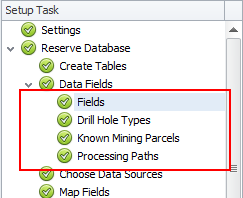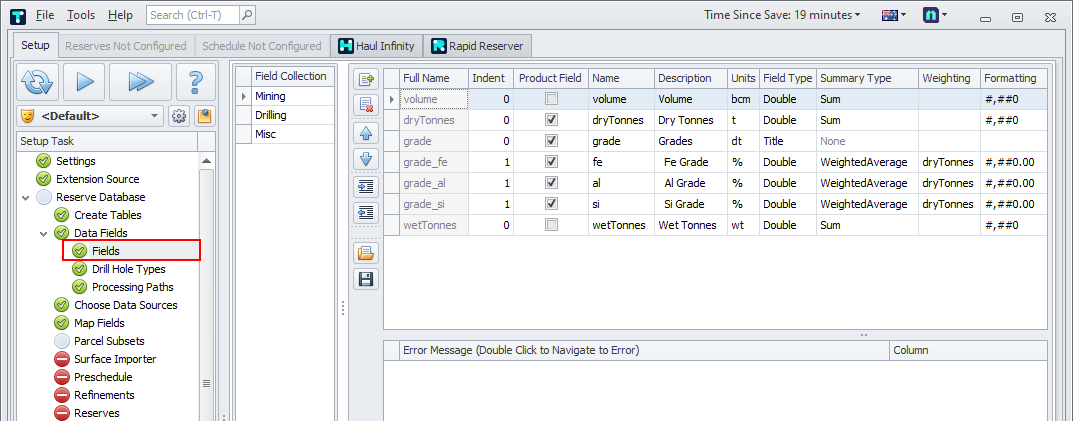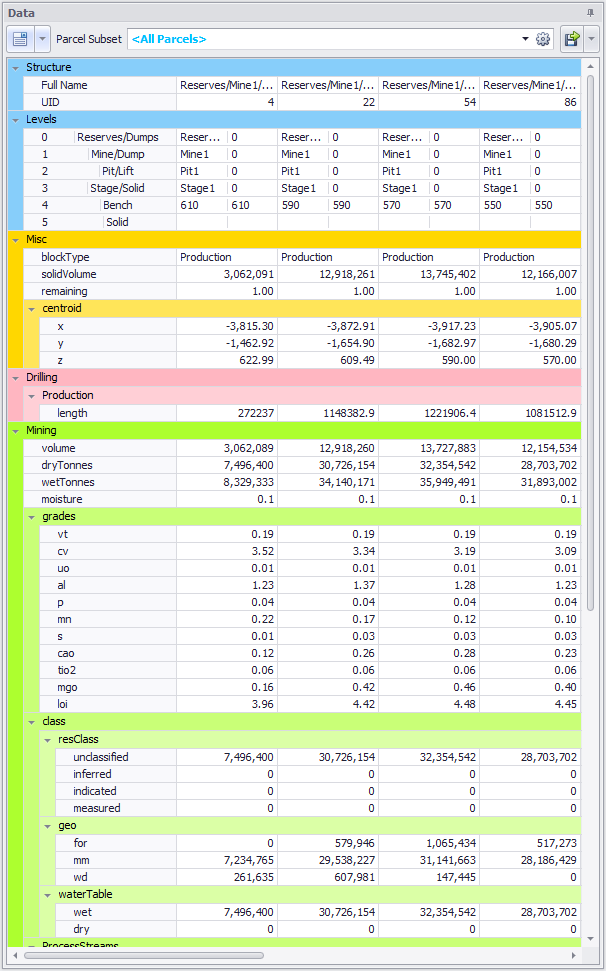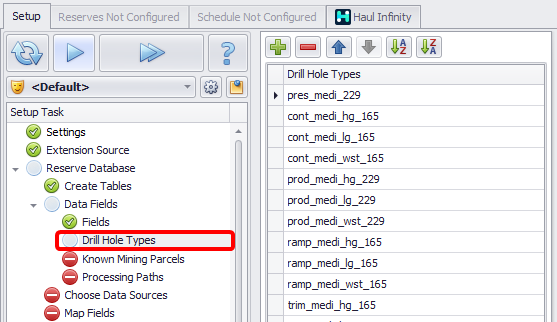Data Fields
In the Setup Task > Reserve Database > Data Fields steps, data fields are created to hold values imported from the inventory files. These may include properties for each block, for the block contents, or for drilling activities.

| Setup Step | Description | |
|---|---|---|
| Fields | Manage field collections for Mining, Drilling and Miscellaneous fields. | |
| Drill Hole Types | Hole types by diameter, pattern size, drill rig, rock type, etc. Note that this step is hidden unless the Schedule Drills flag is enabled in the Configuration Options step. | |
| Known Mining Parcels | Material types which may not be present in the inventory files but must be accounted for in stockpile opening inventories. | |
| Processing Paths | The unique paths to port (i.e. wetPlant/dryPlant), the points at which they are measured (ie. rail/ship), and the different product types (i.e. lump/fine). | |
| Iron ore example: | 'wet_rail_fines' | |
| Gold example: | 'mill_site_gold' | |
If values are not present in the inventory files, then they must be created by script in the Refinements step.
Fields
To display fields specific to different activities, switch between the collections in the Field Collection list:
-
Mining Fields
Mining material properties such as density, moisture, tonnes and grades. Can also include material properties that are measured at every processing path, point and product. For more information, see: Mining Fields
-
Drilling Fields
Hole properties such as length, volume, etc. For more information, see: Drilling Fields
Note that Drilling Fields are only included in the Fields step if the Schedule Drills flag is enabled in the Configuration Options step.
-
Misc Fields
Block properties such as location, volume, depletion, etc. For more information, see: Misc Fields


Fields setup
Fields created in the Data Fields block will be displayed in the Data panel (common for multiple steps and tabs).

Example layout of Misc, Drilling and Mining fields in the reserves.
Field Properties
Each field has a number of properties associated with it.
| Header Field | Usage |
|---|---|
| Full Name | Full address of the field, including parent Title fields (ie. class_waterTable_wet). |
| Indent | An indented field becomes a child of the Title field above it. |
| Product Field | A measure of product value such as tonnes, grades, and class. |
| Name | The name of the field that will appear in the reserves tables. |
| Description | A description of the field. |
| Units | Unit of measurement. |
| Field Type | Fields can be Title, Text, or Double (numeric). Indented fields must have a Title field as a parent. |
| Summary Type | When aggregating records, use Sum, WeightedAverage, Minimum, Maximum, or None. |
| Weighting | For weighted averages, use the weighting dropdown to reference another field. |
| Formatting | Choose how numeric fields are displayed. |
Drill Hole Types
The Setup Task > Reserve Database > Data Fields > Drill Hole Types step is hidden unless the Schedule Drills flag is enabled in the Configuration Options step.
Each pattern has one or more Hole Types to be drilled (for example: Production, Trim, Presplit). If you intend to report blast meters by cost code, then each cost code must be a unique hole code.

Drill Hole Types Setup step
Known Mining Parcels
The Setup Task > Reserve Database > Data Fields > Known Mining Parcels step is optional and is used to add additional material types to Tactical Scheduler that may not be present in the reserves inventory. This may include legacy materials on the stockpiles or known material types that are predicted to be present in future iterations of the schedule.
For more information, see: Known Mining Parcels
Processing Paths
The Setup Task > Reserve Database > Data Fields > Processing Paths step is used to allow product fields to have different values depending on how they are processed, transported and screened.: The unique paths to port (i.e. wetPlant/dryPlant), the points at which they are measured (ie. rail/ship), and the different product types (i.e. lump/fine).
| Iron ore example: | 'wet_rail_fines' |
| Gold example: | 'mill_site_gold' |
For more information, see: Processing Paths